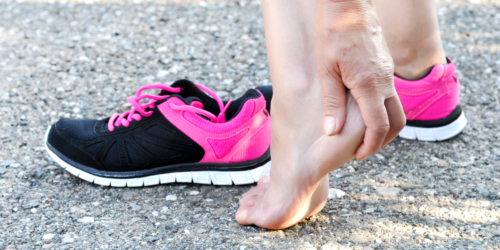Even though it’s great for the heart and lungs and it feels phenomenal, running takes a heavy toll on our bodies. Our feet are especially vulnerable, as they are the foundation on which we stand. Because foot injuries are common among runners, you need to take precautions whenever you run, such as wearing cushioned well fitting running shoes and stretching before you run. Now that Spring is here, many runners will transition from running indoors either on a track or a treadmill to running on pavement. There is a common misconception that you are less likely to sustain a foot injury running on a treadmill than when you run on pavement. The truth is that either surface can cause pain and injury if you don’t take the proper “steps” to avoid problems.
First and foremost, don’t be fooled into thinking that you’re any less likely to injure yourself while running on a treadmill than you are on pavement. Either surface can lead to discomfort, pain or injury if you don’t take the proper “steps” to avoid problems before they begin.
What running on the treadmill does to your feet
Running on any surface results in a powerful force: each time your feet hit the surface on which you run, your falling momentum combines with gravity to create a stronger impact than you know. Thousands of strides per day means thousands of these impacts, potentially multiplied by the number of days per week that you run. Obviously, running on a harder surface will cause more immediate damage to bones and muscles. A treadmill is designed to absorb a great deal of that impact, which is why so many people think it’s the safer option.
Here’s the thing: repetition is the cause of many common types of foot injury, and the amount of repetitive action increases more while running on a treadmill than it does when you run on pavement. On pavement, you turn, you twist, you stop to wait for traffic; or, in other words, you adapt to different types of stress without one constant. On the treadmill, you run, but you don’t twist or turn or stop for a break. It’s constant. Pavement running is a curved line with hills and troughs. Treadmill running is a straight line, and that’s part of the problem. The repetition can cause tendonitis, intermetatarsal neuroma, and injuries in the knees and hips as well as the feet.
That means the transition from one to the other can be harder on your muscles and bones than you might have predicted.
Are natural surfaces a better alternative?
The impact on your feet of running on pavement is greater that you get running on a treadmill. If you feel like running outdoors, a healthier alternative to pavement (or a treadmill) can be found when you run on either grass or sand. In regards to running, softer surfaces are better, as the impact on your feet is greatly reduced. Running on a beach can be especially beneficial, as the resistance of the sand provides a much better cardiovascular workout for your muscles with a lot less wear and tear on your bones.
What you need to know as you transition
Alternate between the two surfaces over a period of two or three weeks, beginning to venture outside only once or twice and slowly increasing the occurrence of pavement running. This will help your body adapt to the different sets of muscles used while you run on either surface. Before you transition, you might consider employing foot exercises to build different muscles than you might not use very often (or at all).
The shoes you wear during your runs can also make a significant difference in reducing the likelihood of injury. That’s because running on any surface with improper footwear can disturb the biomechanical balance of your feet. Walking shoes are designed for walking, and running shoes are designed for running–each type of footwear provides a different kind of cushioning to prevent injury caused by that kind of activity. That’s why custom-built footwear can be a good idea, especially if you’re an avid runner.
For more information on running and foot injuries, call the doctors at Country Foot Care at (516) 741-3338, and make an appointment.


